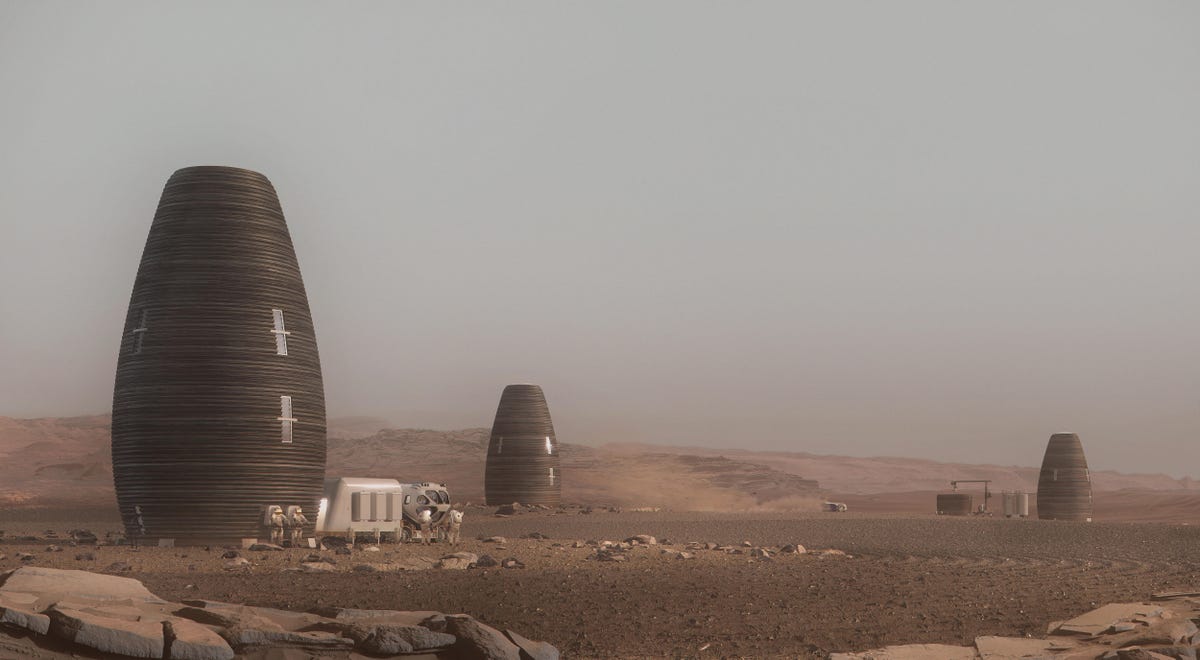This 3D-printed Mars habitat could be your new home in space
Made the months-long journey to Mars but got nowhere to live? One company's vision for a Martian habitat hopes to bring the familiar touches of home to the red planet.

Marsha, the 3D-printed Mars habitat
When life on Earth starts to feel particularly apocalyptic, it's tempting to imagine that humans may one day leave this planet and become an interplanetary species. But though SpaceX and NASA might want to put humans on Mars, what would life look like there long-term? One company has built its vision for the future of life on Mars, designing a habitat called Marsha. The egg-shaped design was created by New York-based architecture firm AI SpaceFactory, in response to NASA's 3D-Printed Habitat Challenge. The company built a one-third scale replica of the habitat here on Earth and took the top prize in NASA's challenge.
3D-printed from Martian rock
AI SpaceFactory set out to design a habitat that could be built by robots, with little human intervention, and that could be constructed from materials that are easily accessible on Mars. Marsha is designed to be 3D-printed using a mixture of ground-up Martian rocks and plant-based polymer. This reliance on "locally sourced" materials means taking less building materials as cargo on the expensive journey from Earth.
Efficiency first
Sci-fi movies like The Martian often show dome-shaped structures in space, but AI SpaceFactory used an egg shape for its design. According to the company, this shape is the most structurally efficient form for a build, particularly when you want to minimize the materials needed for construction.
Practice build
AI SpaceFactory conducted a practice build for Marsha at the Autodesk Technology Center in Boston. There, the team was able to work on aspects of the design and to build using 3D-printing processes similar to what might one day be used on Mars.
The circle of life-on-Mars
One of AI SpaceFactory's employees looks on during a practice build of a scale model of Marsha.
Natural light
Marsha features a double-walled design with a skylight at the top, which allows natural light to filter down between the shells and light up all four levels.
Earth-like interiors
Marsha's double-walled structure also helps the habitat withstand the pressures of being in space. The Martian atmosphere outside is much thinner than the Earth-like atmosphere inside, so AI SpaceFactory had to design for internal air pressure. That double-walled design stops the habitat from expanding out like a balloon.
Room to move
The design features stairways built into the curved structure that allow residents to move easily between levels.
The ground floor
On the ground level, Marsha features a garage and wet lab with space for inhabitants to work.
Illuminated
Even on the ground floor, light filters down from the above skylight, allowing the crew to work comfortably as they would back home.
Preparing for the outside world
The ground floor also features a space for EVA prep, where astronauts can prepare for "extravehicular activities" that'll take them outside into the Martian environment.
The second floor
The second floor features more communal space, with a kitchen and dry lab.
Dinner is served
The office space sits alongside the kitchen area on the second floor. Though you wouldn't expect to be eating many gourmet, three-course meals, you might still prepare food grown on Mars (like potatoes, served a la "The Martian").
3D-printed curves
The curves of the 3D-printed structure give Marsha a more organic feel, despite the highly technical nature of the space.
The third floor
The third floor features a garden and sanitation pod as well as personal spaces for the inhabitants. One of the key design considerations for AI SpaceFactory was creating a space that felt natural and human-centric, with private space to recharge.
Private space
Inside one of the personal pods in Marsha. Even on Mars, AI SpaceFactory likes to think, there'll still be time to video chat with your friends.
The top floor
On the fourth floor of Marsha, a communal recreation and exercise space takes advantage of the light from the skylight above.
Work, rest, play
Isolation will be a big factor for travelers to Mars. AI SpaceFactory wanted to create a space where inhabitants could still enjoy some down time.
Life on Mars
AI SpaceFactory's vision for the future of Martian habitation may be a long way off, but the company hopes that one day life on Mars will be within reach of humans on Earth.
A terraformed planet
"Living on Mars is for the adventurous," says AI SpaceFactory CEO David Malott, one of the key people behind Marsha. "I think there's a certain romance of going to a place that no one has gone before."

